Film Study: Never Satisfied, Nikita Kucherov Wants to Be as Unpredictable as Possible

As the film session begins, Nikita Kucherov sets one ground rule straight. “No goals,” he says. “I don’t like talking about goals. Obviously I made something right, so what’s the point of watching? You should ask me something else.”
To Kucherov, success is a sucky teacher. The 25-year-old winger studies each of his shifts on an iPad following every Tampa Bay Lightning game, not for the purpose of reliving highlight-reel plays—from which there are many to choose, to be sure, after just the third 100-point season in franchise history—but because he always discovers open teammates he should’ve seen, or better moves he could’ve tried, or smarter decisions he should’ve made. “Never good enough,” says his agent, Dan Milstein. “Never satisfied.”
Indeed, Kucherov is famous among his hockey circle for both self-criticism and seriousness. It’s why Milstein chuckles at the events of last New Year’s Eve, when Blue Jackets forward Artemi Panarin predicted that Kucherov would be in a sour mood … even though Tampa Bay had spanked Columbus, 5–0, and Kucherov had notched two points against his close friend. And the events of July 10, when Kucherov signed an eight-year, $76 million contract extension, but refused to celebrate with a slice of cake over dinner, citing its shoddy nutritional value.
It’s also why Milstein suggested that our brief interview window here, inside a windowless conference room at a downtown Chicago hotel on the first afternoon of NHL media days, would be best spent watching tape, listening to Kucherov break down the minutiae of his skills and picking his brain for intel.
This recommendation did not disappoint.
Okay, no goals. Very well. This rules out 39 potential sequences from the ‘17–18 regular season, including the NHL’s second-most backhands (eight), fourth-most wrist shots (24), and the mind-melting fakeout that he pulled (again) on Capitals goalie Braden Holtby. Or the five additional tallies in as many games against New Jersey during the first round.
Fortunately for the benefit of this exercise—because I hadn’t considered combing through the archives for mistakes—Kucherov allows a small concession. “Let’s watch assists,” he says, turning to face an open laptop on the table. Up comes a clip from the third period on Jan. 25, a 5–1 road win against Philadelphia and one of Kucherov’s four three-assist games last season:
Seven seconds later, Kucherov taps the spacebar to pause and scoots closer. “Can we go back?” he says. The sequence loops again. At the top of the screen, Lightning captain Steven Stamkos carries the puck across the offensive blue line. At the bottom, Kucherov glides through the neutral zone and surveys the scene. In the conference room, he starts to narrate.
“I saw two guys over-backcheck,” Kucherov says. “Sometimes they just put [their] head down and skate and don’t look. I saw Stammer looking for somebody because he’s in a tough position. Then I saw [former linemate Vladislav Namestnikov] and [defenseman Anton Stralman] driving to the net, so he can’t make any plays to them.”
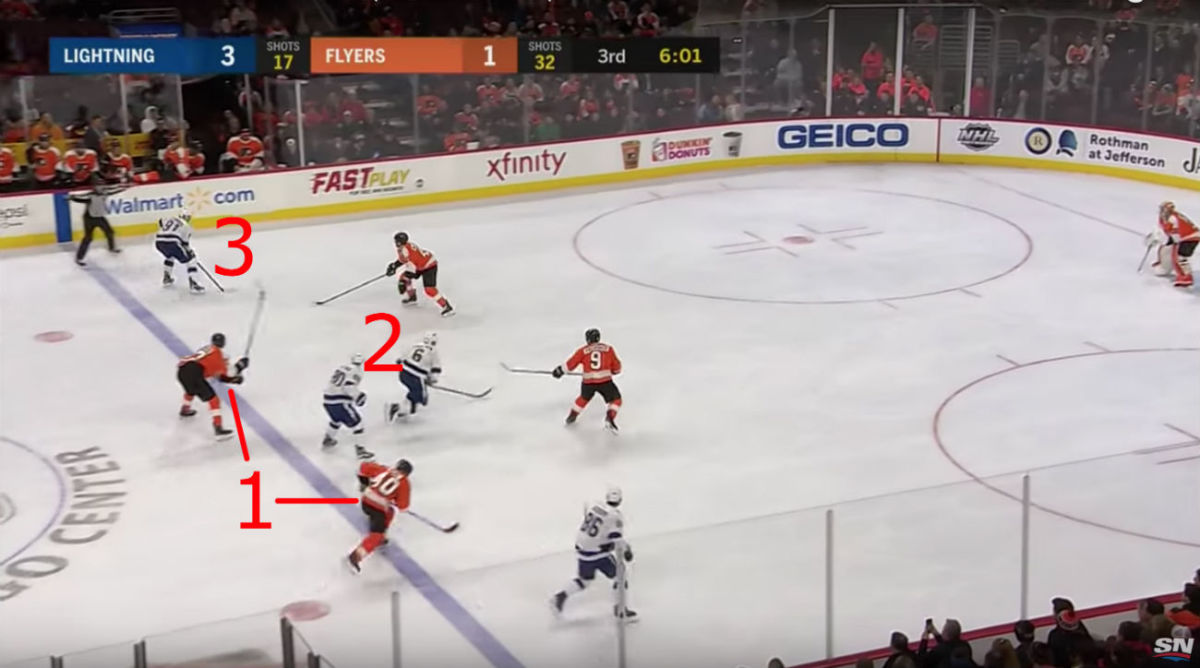
As Kucherov crosses the blue line, he performs some swift mental calculus. The weak side is wide open if he wanted to bolt backdoor. But with bodies and sticks clogging the slot, a clean pass from Stamkos is virtually impossible. And besides, Kucherov loathes these types of long-shot attempts, where odd-man rushes die because someone funnels a limp backhander toward the crease and hopes for a fortunate bounce off the goalie’s leg pads.
“Most coaches want [their players to] drive the net,” he says. “Then once you score a goal, they think that’s a set play. But this happens once a year. But what if you try [an] unpredictable play? When you do something unpredictable, that’s where guys don’t know what to do, and the more you do it, the more success you have.”
And so Kucherov decides to do something unpredictable: He slows down and turns back. “I’m buying time for number 40 to catch me,” Kucherov says, referring to Flyers forward Jordan Weal. “That’s where I can separate myself from him. Quick turn. I see him going straight. That’s where I catch him. Everybody wants to backcheck hard, but you have to work smart.”
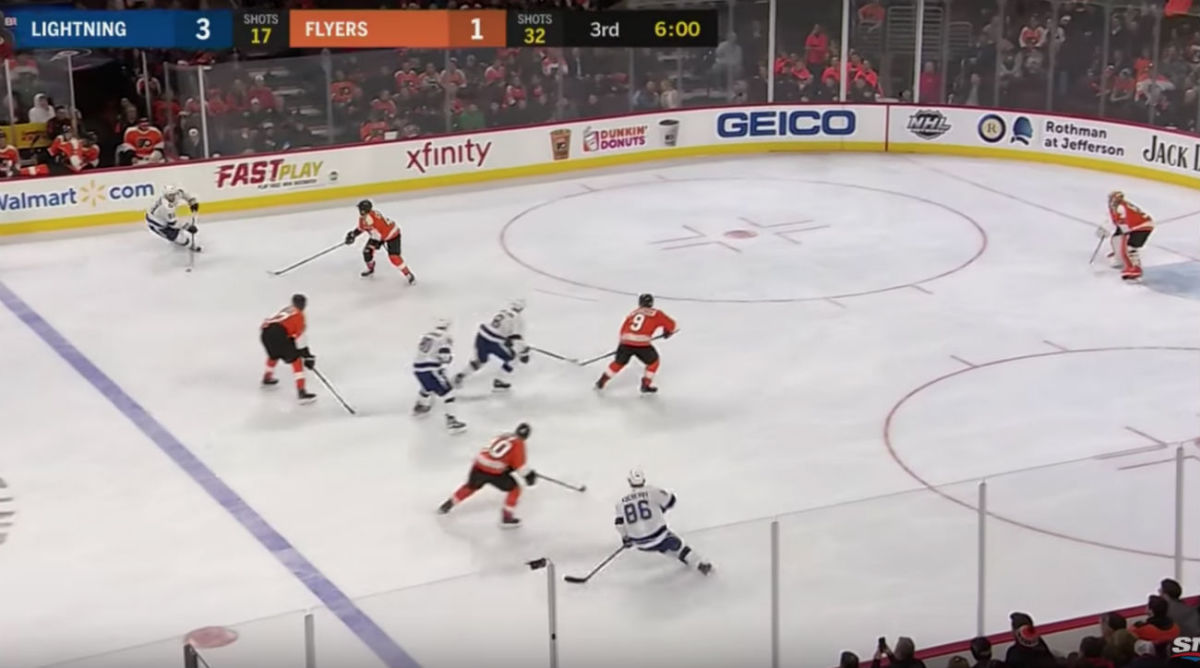
It is a classic Kucherov move, hitting the breaks while everyone else skates at full sprint, zigging while the field zags. “He definitely thinks on another level,” Lightning assistant coach Todd Richards says. “And he sees things on another level.”
Much to the benefit of Tampa Bay, which reached its third conference finals in four years before falling to Washington, so does his center on the Lightning's top line. At the same moment that Stamkos pulls up with the puck, Kucherov makes his move. “We buy, I don't know, half a second for each other and we can make plays,” he says.
Looping behind the hard-charging Weal, Kucherov angles toward the high slot and presents his stick for Stamkos. As linemates they often discuss “getting open” for the other person, a skill that Kucherov admires in his favorite basketball and soccer teams. “Warriors, they play really good,” he says. “You see they [pick] for each other, they switch, make passes. It’s all hockey too. If you have somebody who understand[s] the way you understand, this [is] what you get.”
When Kucherov first joined the Lightning after a brief stint with their minor league affiliate in ‘13–14, he paid special attention to the way Stamkos and Hall of Fame winger Martin St. Louis interacted at practice. “They were talking about a play, I would see it the same way,” Kucherov says. “I thought we had a lot of similarities.”
Now he feels that connection with Stamkos. "It’s good to have Stammer beside me," Kucherov says. "I know what he thinks." A brief stint in ‘16–17 was cut short when Stamkos suffered a torn meniscus, but together they outscored opponents 53–38 in almost 800 minutes at 5-on-5 last season. "He’s got unbelievable skillset, so it’s easy for me to play with somebody like him," Kucherov says. "But if somebody else is on the ice, you have to adjust to him and make him better. If it’s not Stammer, somebody else, you have to spend time with him. You have to go on the ice, spend extra time for some little plays, just help him be better than he is, and that’s going to help my game, too.
"I don’t want him to affect my game, so I’m going to help him. Then it’s nice to see after a few years he gets good money. Then you think you have a little piece that you helped him, too."
What happens next against Philadelphia, however, is all Kucherov. No superstar symbiosis necessary. “I use the spin-o-rama,” he says. “That's where I caught him again [a] second time.”
Another tap of the spacebar. As Stamkos prepares to slide the puck over, Kucherov has noticed that Weal is recovering and giving chase. “I saw him coming hard and he swing left,” he says of Weal. “His body’s moving that way toward me, basically toward Stammer. I can’t continue going that way.”
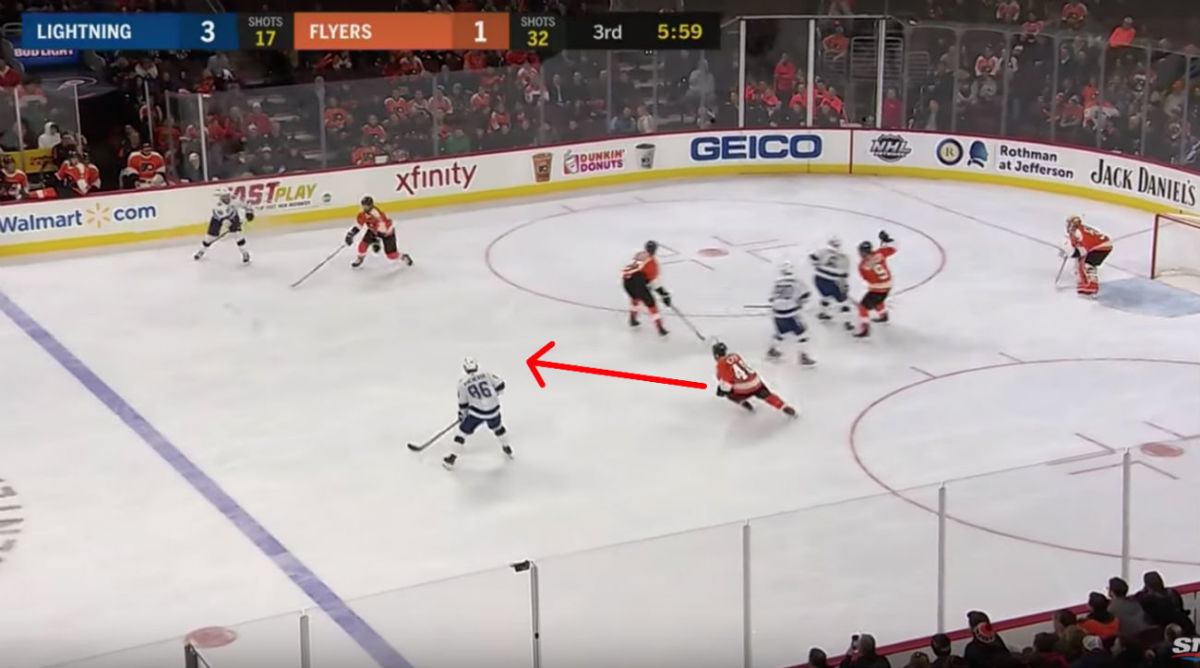
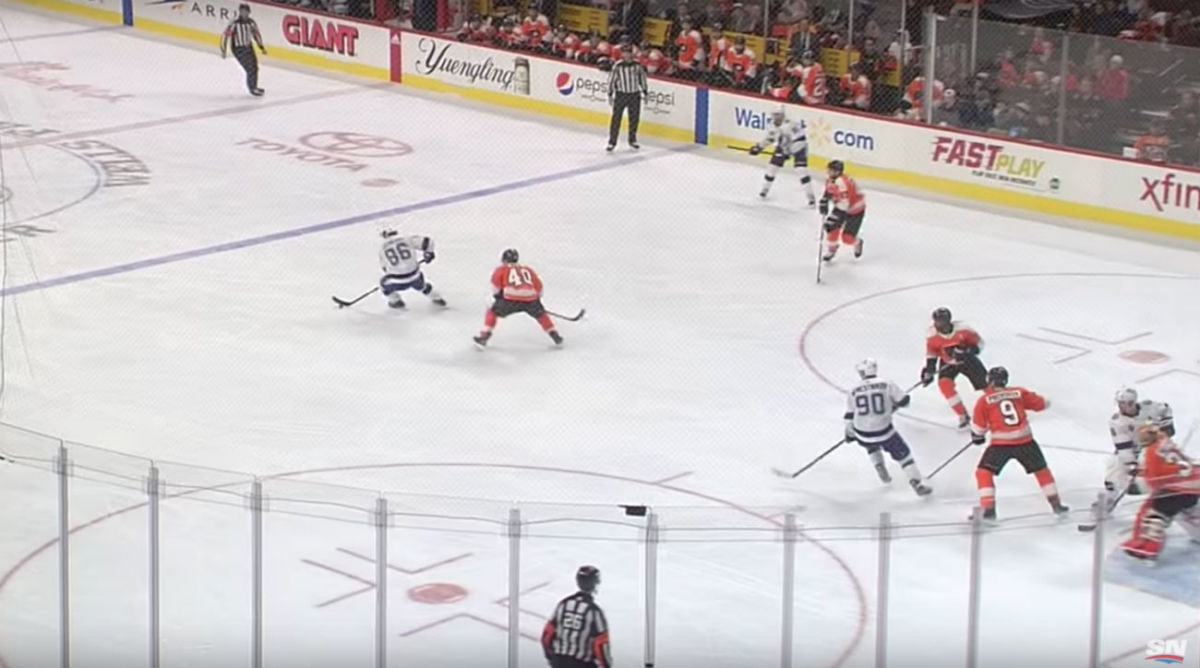
The pass hits Kucherov on his forehand, but quick wrists and faster feet help him whirl past an off-balance Weal, who can only flail a stick in protest.
Knowing that Weal is right-handed, Kucherov protects the puck with his back and heads into the slot, where Flyers winger Wayne Simmonds has stepped up to help defense. “I beat my guy, so Simmonds has to think, ‘What am I going to do? Going to let Kuch walk in the middle, or release Vladdy and step up?’” he says.
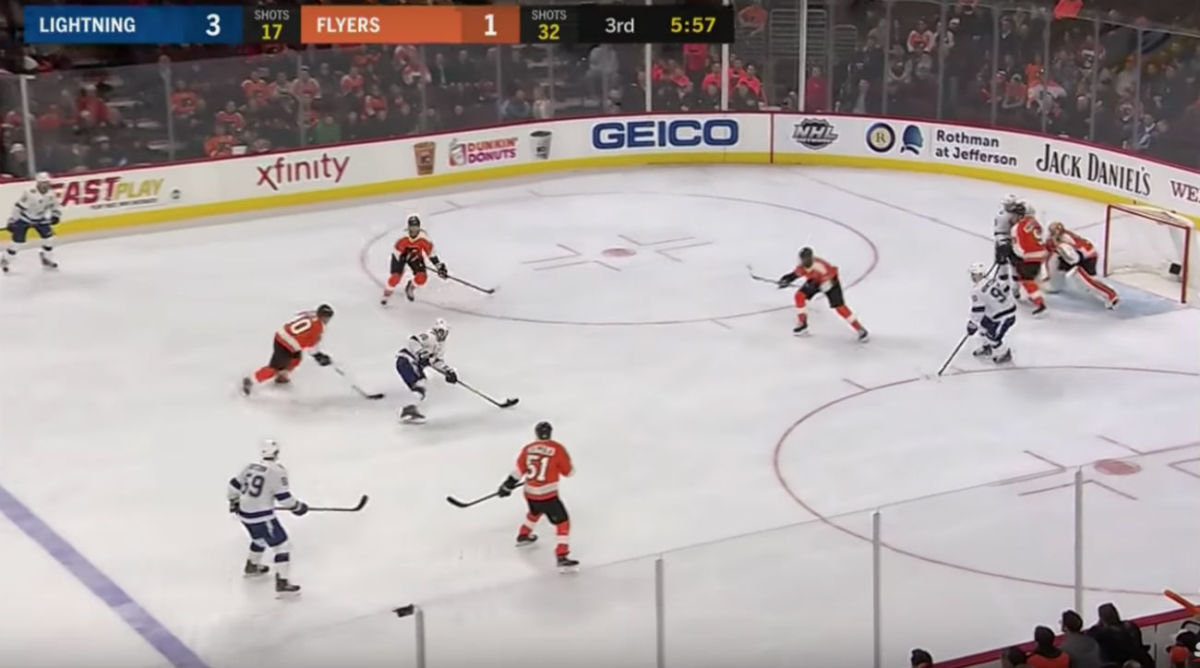
As Kucherov did for Stamkos, so too does Namestnikov get open for Kucherov, retreating toward the right face-off dot and angling for a one-timer. “That’s where not too many guys can understand that, get open for each other,” Kucherov says. “I think you learn that as a kid from the beginning. You develop your skill set of thinking, play different games like basketball, soccer … In that clip, we all three involved and we got rewarded.”
Before he was traded to the Rangers in the Ryan McDonagh/J.T. Miller deadline blockbuster, Namestnikov had served as one of Kucherov’s post-practice drill partners, sticking around late to incubate new moves. “He’s constantly consumed by creativity and offense,” says Richards, who recalls occasionally letting Kucherov take charge during power-play work so he can better teach his teammates.“It’s how he thinks ahead. And the reads and the things that he sees, maybe how a defenseman holds his stick, or positioning, or even a goaltender. I think he picks up on those subtle things that allow him to be more dynamic offensively.”
This inventive ethos was imprinted into Kucherov from an early age in Moscow; a die-hard fan of the famed Russian five, he mostly credits the tutelage of a youth coach named Gennadi Kurdin. It has since been reinforced through conversations with fellow players around the NHL during his five electric seasons in Tampa.
“Everybody is really predictable,” Kucherov says. “Every team plays the same way. I don’t want to be predictable. Once you score a goal, it’s all over the internet and then you have to come up with something else. You always want to be unpredictable. That’s what I enjoy about the game.
“Maybe it’s a more risky play, but that’s hockey. The fans are sitting there to watch hockey. A lot of kids coming in want to watch skilled players do skilled thing[s]. They don’t want to see Stammer come here and backhand to the pad. What is this? What kid is going to come here to practice tomorrow and do the same thing?”
More likely: Some children in the greater Tampa area awoke on Jan. 26, checked the highlights on NHL Network and started imitating Kucherov’s spin-o-rama. Maybe one of their friends served the role of Namestnikov, clubbing a goal from below the dot. Or perhaps they were just like the Lighting players on the bench at Wells Fargo Center, craning their necks for another look, wondering what was going through Kucherov’s mind to even think about trying something like that.
